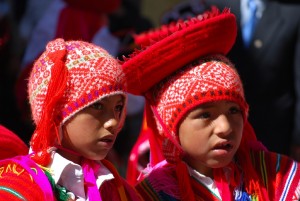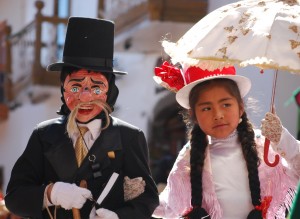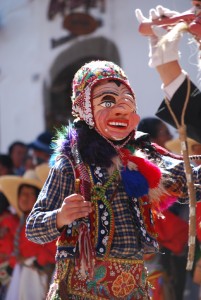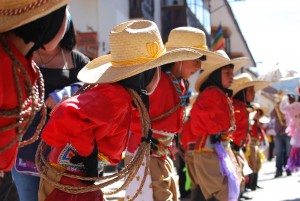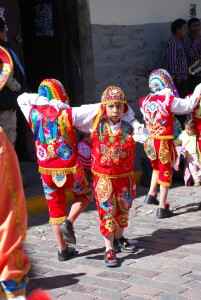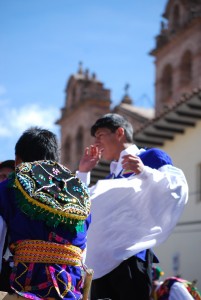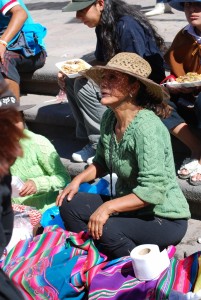Garcilaso School Dances Pride Today

During this jubilee month, Cuzco’s Plaza de Armas once again is the stage for parades, feasts, and dances, all of them filled with allegories. One of these activities is the “pasacalle” or “going through the street” of the Gran Unidad Escolar Inca Garcilaso de la Vega, the Great Educational Unit Garcilaso Inca de la Vega, one of Cuzco’s largest and most important public schools.
On the 19th of June, every year, a day filled with color, the students of Garcilaso enter the street with their dance troupes. They are proud to demonstrate to all their skill and talent in their dances, at the same time by performing well they show their love for their school and hold its name high before all of Cuzco.
They begin at 1 pm, after other schools have danced before the reviewing stand on the plaza all morning. People fill the edges of the streets in great anticipation, opening spaces for the dancers.
These days the municipality enforces a strict schedule for all festivities, including the pasacalles of the city’s institutions, schools, markets, and neighborhoods, as well as other activities.
Nowadays this pasacalle is even more important for the school. Its campus is being remodeled and new buildings constructed. As a result, its different levels are scattered in other spaces throughout the city.


The first group to open a path among the hordes of spectators is the primary school. Because of their youth and the vigor with which they perform, they make the audience feel warm fuzzy. Their well crafted costumes and choreographed dance steps cause people to feel lots of emotion. They laugh and smile and just feel good as they watch the children perform with surprising skill.
Since Garcilaso is a boy’s school, the youth from high school invite the girls from several schools for young women–Clorinda Mato de Turner, Comercio 41, Educandas and others to join them in performing. In this way, they dance in the couples required by so many traditional dances and so important for our Andean thought.
The different dances presented by each grade in this “parade” are from the regions and districts of Peru, although sometimes they also perform sayas and morenadas from our sister republic of Bolivia. Of course, since the Peruvian region of Puno shares much of the dance culture of Bolivia, one can argue–whether the Bolivians like it or not–that these dances are also Peruvian. They have certainly become very popular here recently.
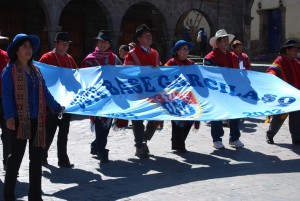
Garcilaso’s administration gives awards to the three best dance troupes which include money so that when they graduate they can make a trip.
To compete for the prize, the professors and students of the different grades organize themselves well in advance to rehearse the different dances. One week before the pasacalle, they begin rehearsing intensively with lots of enthusiasm and hope.
This is an important event in the life of the students and even years later they remember the work and pleasure with great enthusiasm.
As the week advances, the best dancers are selected to perform in the final group that will represent the grade. To see the organization, the skill, and the desires of the students to dance with all their heart is truly impressive. They work as hard as they can during this week to be among the selected group and carry the honor of their classroom and grade high.
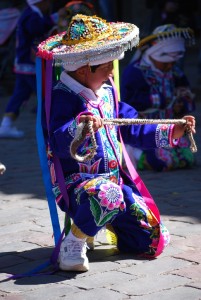
The students who do not make the cut, also organize to play a role in the performance. They dress and act as pseudo reporters. All along the dance route they accompany their peers who are dancing and their job is to get people to laugh and have lots of fun. As reporters they play a traditional Andean roll of the clown who brings humor by breaking the seriousness of events. While other people just want to see the students dance with their whole being, the clowns make them laugh.
All the public is caught up in the energy of the event, filled as it is with color, movement, and a range of emotions.
Cuzco’s visitors also enjoy the event, so different from what goes on in their home towns and countries. At times the route, especially in front of the judging stand, fills with the popping lights of an army of flashes from so many cameras.
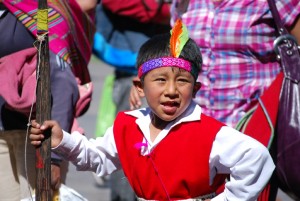
When the dancers pass in front of the main stand, which itself sits in front of the Cathedral’s doors, the dancers are caught up in the moment and dance with everything they have. Not only do they dance, sometimes they also sing in unison. One can notice that most of the choreographies represent the initials of the school in a mixture of tradition, culture, and pride.
The school’s former students also gather in the plaza to support the dancers. They enjoy the moment and they relive their glory days of school with their mates. They too take to the streets at the end of the festivity to march and be present on this important day for their school.
In this way, the spirit of the Garcilaso School is rebuilt and polished. Its graduates are a major force in Cuzco’s life and the solidarity among them crosscuts so many other social and institutional differences to be a fore for unity in the city.
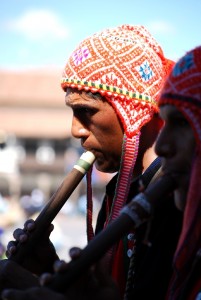
I am a graduate of Garcilaso and as I was talking with my friends who are former students as well, and also former performers, the way they told their experiences caught my attention. It seemed they returned to live each moment as they spoke, and how they said that on this day the whole “Garcilacina Family” comes together again in a reunion filled with emotion.
I remember how ten years ago the festivity would last until three or so in the morning.The Plaza de Armas would be completely filled the whole time with people awaiting for their children, relatives, friends, or just acquaintances to dance by.
Now, by order of the municipality, events such as this must end at eleven pm when the municipal workers come out to clean the Plaza and prepare it for the next day’s events.
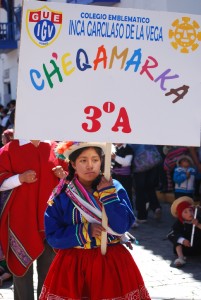
During this event there are always vendors of sweets, street food, fava bean punches, brazil nuts, and chocolates to keep the energies of the dancers and spectators from flagging and especially keeping them warm in the cold of the night.
On the other hand families also come prepared with refreshment and snacks, such as sandwiches, pastries, ponches or coffee. When the children finish dancing they are exhausted, and they will generally share a refreshment with their family, whether something bought or brought, in order to refuel them with energy after all theri effort.
The focus of these last days before Inti Raymi and the Day of Cuzco shines brightly on the city and region, but within it, one can see the brilliant sparkle of important institutions like Garcilaso and its family of current and former students and their families that stretches across the city with pride.
